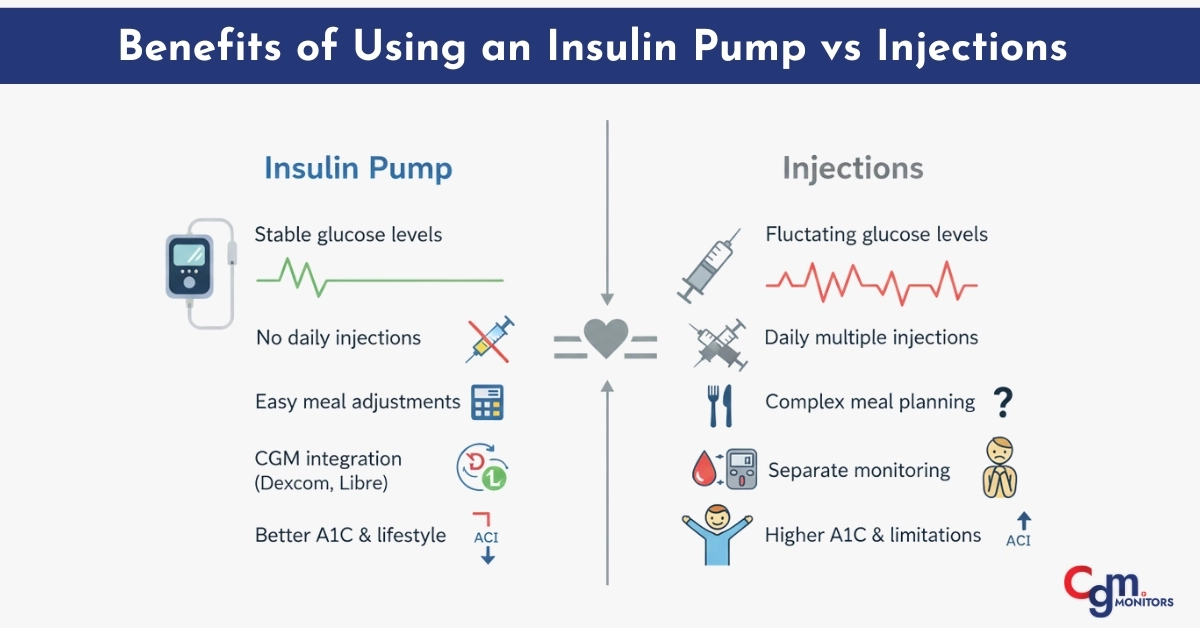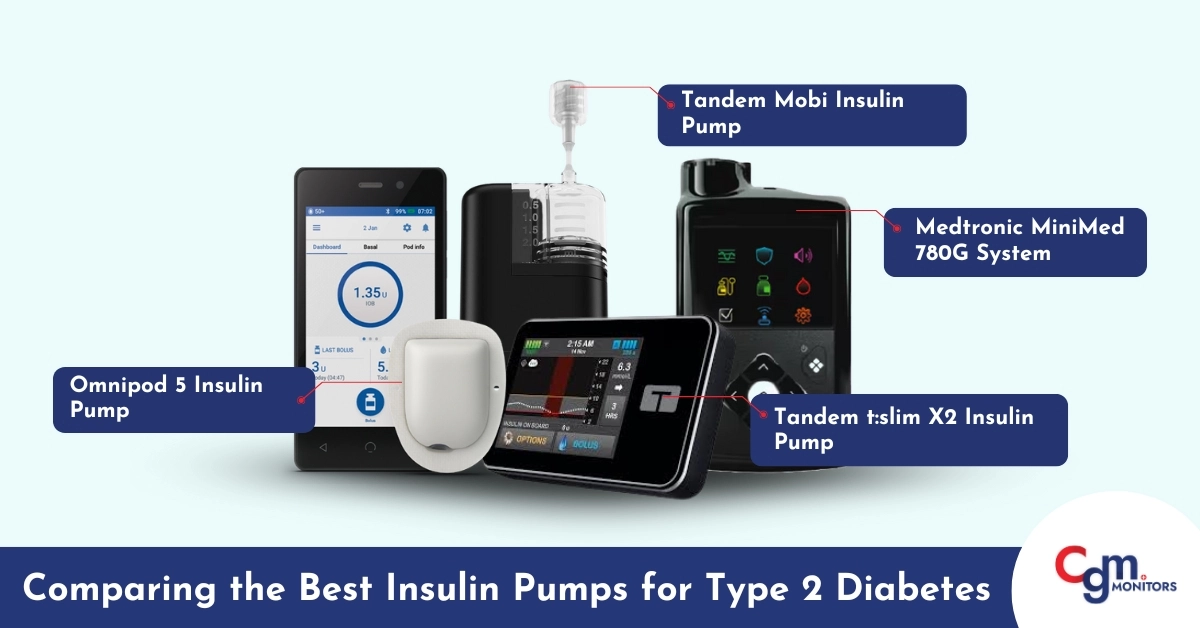Table of content
- Understanding Insulin Pumps for Type 2 Diabetes
- Benefits of Using an Insulin Pump vs Injections
- Comparing the Best Insulin Pumps for Type 2 Diabetes
- Insulin Pumps NOT for Type 2 diabetes:
- Key Considerations for Type 2 Diabetes Management
- What Suits Best for You in Selecting Insulin Pump
- Conclusion:
- Frequently Asked Questions
Managing Type 2 diabetes effectively requires more than just discipline — it demands the right technology to maintain stable glucose levels without constant finger pricks. Among the most advanced solutions available today are insulin pumps, small yet powerful devices that deliver precise doses of insulin throughout the day.
If you’ve ever wondered which is the best insulin pump for Type 2 diabetes, this comprehensive guide covers everything — how insulin pumps work, their benefits, brand comparisons, user experiences, and how to choose one that fits your lifestyle.
Understanding Insulin Pumps for Type 2 Diabetes
An insulin pump is a small computerised device that delivers insulin continuously through a thin tube or patch. It mimics how the pancreas releases insulin naturally, maintaining steady blood glucose levels.
Can Type 2 diabetics use an insulin pump?
Yes. While insulin pumps were initially designed for people with Type 1 diabetes, more doctors now recommend them for Type 2 patients who need multiple daily injections or struggle to keep A1C levels under control.
How do insulin pumps work for Type 2 diabetes?
They provide two types of insulin doses — a basal rate (steady background insulin) and a bolus dose (extra insulin when you eat). This helps prevent glucose spikes and supports better long-term control.
Benefits of Using an Insulin Pump vs Injections
- Consistent glucose management with fewer highs and lows
- No need for multiple daily injections
- Easier adjustments for meals and exercise
- Integration with Continuous Glucose Monitors (CGMs) like Dexcom G7 or G6 Sensor or Freestyle Libre 2 Plus Sensor.
- Better A1C outcomes and quality of life.

Comparing the Best Insulin Pumps for Type 2 Diabetes
Choosing the best insulin pump depends on your lifestyle, comfort, and budget. Let’s compare the leading options available in 2025.
1. Omnipod 5 for Type 2 Diabetes
The Omnipod 5 G6 Intro Kit is one of the most popular tubeless insulin pumps. It works seamlessly with the Dexcom G6 CGM, creating a smart insulin pump system that adjusts insulin delivery automatically.
Key Features:
- No tubing — completely wireless
- Automated insulin delivery with CGM feedback
- Waterproof and discreet
- App-based control for Android and iOS
Best for: Active users and those seeking simplicity and automation.
2. Tandem t:slim X2 Insulin Pump
The Tandem t:slim X2 is a touchscreen insulin pump integrated with Control-IQ technology and compatible with the Dexcom G6 and G7 sensors. It’s FDA-approved for both Type 1 and Type 2 diabetes.
Key Features:
- Rechargeable touchscreen interface
- Works with Dexcom CGM
- Automatic insulin adjustment
- Sleek, compact design
Best for: Tech-savvy users who want advanced automation and CGM integration.
3. Medtronic MiniMed 780G System
The Medtronic MiniMed 780G remains a trusted name in insulin delivery. This hybrid closed-loop system uses SmartGuard technology to adjust basal and bolus insulin based on glucose trends.
Key Features
- Auto correction boluses every 5 minutes
- Built-in CGM integration
- Personalized insulin delivery
- Works well for users who prefer all-in-one systems
4. Tandem Mobi Insulin Pump
The Tandem Mobi is one of the newest and smallest insulin pumps for Type 2 diabetes. Its compact, wearable design connects directly with Dexcom G7 and the Tandem app.
Key Features
- Smallest tubed pump available
- Direct app control
- Water-resistant
- Compatible with Dexcom CGMs
Best for: Modern users seeking portability and smartphone integration.
Important: When using Tandem Mobi, be aware that although the system can be used by individuals aged 2 and above, the Control-IQ+ technology is indicated for type 1 diabetes in individuals aged 2 and above, and for type 2 diabetes in individuals aged 18 and above.

Insulin Pumps NOT for Type 2 diabetes:
Some of the insulin pumps may look attractive due to their features; however, they have specifically been indicated for Type 1 diabetes. Among these are the pumps which have not been tested on type 2 patients or simply not approved for type 2 due to some dangers. Following is a list of some famous insulin pumps indicated for type 1 diabetes;
- iLet Bionic Pancreas
- MiniMed™ 780G
- Medtronic MiniMed 770G
- Medtronic MiniMed 630G
Did you know?
Claiming your required medical equipment using insurance is easy with CGM Monitors. All you need to do is fill out a benefit check form and wait until we get back to you.
Key Considerations for Type 2 Diabetes Management
Tubed vs. Tubeless: Tubeless pumps like the Omnipod 5 offer greater flexibility and are less noticeable, which can be beneficial for active individuals.
CGM Compatibility: Integration with CGMs such as Dexcom G6, Dexcom G7, or Freestyle Libre 2 plus systems allows for real-time glucose monitoring, enhancing automated insulin delivery.
Automation Features: Hybrid closed-loop systems e.g., Tandem Control-IQ and automated bolus delivery, e.g., Omnipod 5, can significantly improve glucose control with minimal user input.
Smartphone Integration: Most modern pumps offer smartphone apps for remote monitoring and control, providing convenience and real-time data access.
Waterproofing: Water-resistant or waterproof pumps are advantageous for individuals who engage in swimming or other water activities.
Battery and Insulin Storage: Rechargeable batteries and larger insulin reservoirs (up to 300 units), as offered in “Tandem t X2 (Control-IQ), reduce the frequency of replacements and refills.
What Suits Best for You in Selecting Insulin Pump
Choosing the best insulin pump for Type 2 diabetes depends on your lifestyle, budget, and comfort with technology.
- Omnipod 5 – Best for active users who want a tubeless, automated system with Dexcom G6 integration and smartphone control.
- Tandem t:slim X2 – Ideal for tech-savvy users needing advanced Control-IQ technology and CGM-based insulin adjustments.
- Medtronic MiniMed 780G – Great for those who value trusted accuracy and an all-in-one hybrid closed-loop system.
- Tandem Mobi – Perfect for minimalists who prefer a compact, app-controlled, and water-resistant pump.
- Omnipod DASH – Best for budget-conscious users seeking a simple, affordable, and insurance-covered option.
Conclusion:
While choosing an insulin pump that suits you the best may be a bit difficult, it’s essential to consult with your healthcare provider to determine the most suitable insulin pump based on your specific requirements and preferences. Moreover, keep in mind that these insulin pumps work in connection with CGM systems, such as Freestyle Libre 2 Plus sensors. Thus, when selecting your insulin pump, make sure that it works with your CGM as well.
Disclaimer: This blog is only for informational purposes and does not substitute your doctor’s advice.
Frequently Asked Questions
What is the approved insulin pump in Type 2 diabetes?
FDA approved Type 2 diabetes can be managed by the Omnipod 5, Tandem t:slim X2 with Control-IQ, and Medtronic MiniMed 780G. They are automated insulin pumps and can be connected with CGMs such as the Dexcom G6 or the Dexcom G7 to maximize glucose management.
Is an Omnipod available to a Type 2 diabetic?
Definitely, Omnipod DASH or Omnipod 5 systems can be used by Type 2 diabetics. They are tubeless, discreet and useful in the flexibility required by individuals who do not require injections often. Omnipod is currently covered under numerous insurance schemes of Type 2 users.
What is the cost of an insulin pump to Type 2 diabetes?
The price is dependent on brand and insurance. Insulin pumps are estimated between 4000-7000 dollars on the initial investment, the supplies and insulin may cost 300-400 a month on average. In most cases, insurance will provide a huge portion of the cost when it is medically necessary.
Is insulin pump better than injections?
Yes, insulin pump provides superior glucose control, a reduced incidence of hypoglycemic episodes, and better A1C results in a large population of patients as opposed to injections.
What are the disadvantages of an insulin pump?
Cost of devices, periodic site irritation, risk of infection, and the probability of technical errors, are some of the challenges associated with it. Nonetheless, the advantages, particularly better glucose control, of it are more than the disadvantages to most users.
What will the latest insulin pump be in 2025?
Some of the most recent systems that received FDA clearance are: Tandem Mobi Insulin Pump and Omnipod 5 G6 as of 2025. They both have smartphone control, enhanced connectivity and closed-loop automation that is hybrid to enhance the management of insulin.







Write a comment
Your email address will not be published. All fields are required